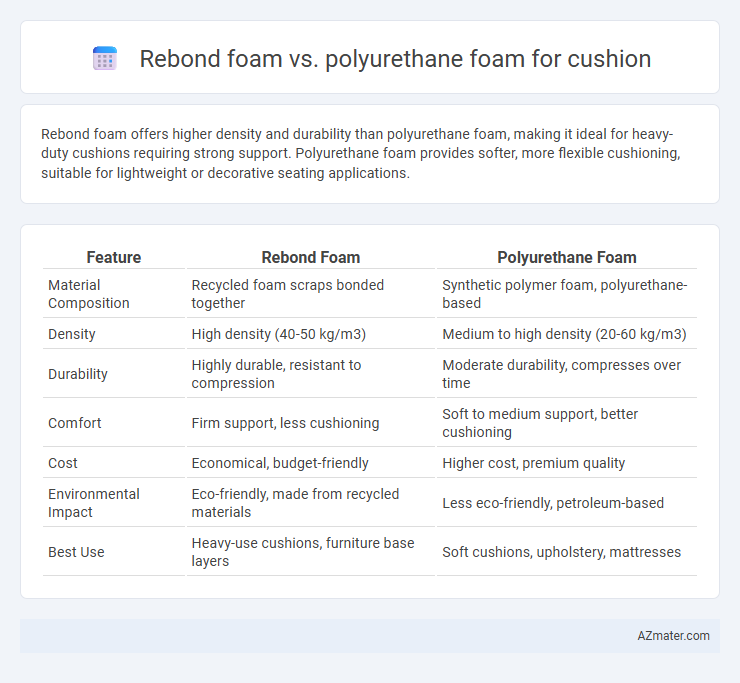Rebond foam offers higher density and durability than polyurethane foam, making it ideal for heavy-duty cushions requiring strong support. Polyurethane foam provides softer, more flexible cushioning, suitable for lightweight or decorative seating applications.
Table of Comparison
| Feature | Rebond Foam | Polyurethane Foam |
|---|---|---|
| Material Composition | Recycled foam scraps bonded together | Synthetic polymer foam, polyurethane-based |
| Density | High density (40-50 kg/m3) | Medium to high density (20-60 kg/m3) |
| Durability | Highly durable, resistant to compression | Moderate durability, compresses over time |
| Comfort | Firm support, less cushioning | Soft to medium support, better cushioning |
| Cost | Economical, budget-friendly | Higher cost, premium quality |
| Environmental Impact | Eco-friendly, made from recycled materials | Less eco-friendly, petroleum-based |
| Best Use | Heavy-use cushions, furniture base layers | Soft cushions, upholstery, mattresses |
Introduction to Foam Types in Cushioning
Rebond foam is made from shredded scrap polyurethane foam bonded together using adhesive, resulting in a denser and more durable cushioning material often used for high-impact applications. Polyurethane foam, a versatile synthetic material, offers various densities and firmness levels, making it suitable for comfort and support in seating cushions. Understanding the composition and properties of each foam type helps select the right cushioning for specific needs, balancing firmness, durability, and cost-effectiveness.
What is Rebond Foam?
Rebond foam is a dense, durable material made from shredded polyurethane foam pieces bonded together using adhesive, offering superior resilience and support compared to standard polyurethane foam. It provides excellent pressure distribution and maintains shape under heavy use, making it ideal for high-traffic furniture cushions and gym mats. Its recycled composition also makes rebond foam an eco-friendly choice without compromising comfort or durability.
What is Polyurethane Foam?
Polyurethane foam is a versatile synthetic material widely used for cushion padding due to its excellent resilience, comfort, and support properties. It is created through the chemical reaction of polyols and diisocyanates, resulting in flexible foam that can vary in density and firmness to suit different applications. Unlike rebond foam, which is made from shredded polyurethane foam pieces bonded together, polyurethane foam offers more uniformity and flexibility, making it ideal for cushioning in furniture, bedding, and automotive seats.
Key Differences: Rebond Foam vs Polyurethane Foam
Rebond foam is made by compressing and bonding shredded polyurethane foam scraps, resulting in a denser and more durable material ideal for heavy-duty cushioning and high-impact applications. Polyurethane foam, produced through chemical reactions creating a flexible and lightweight structure, excels in providing softer comfort and better cushioning for everyday furniture and bedding. Key differences include rebond foam's superior support and resilience compared to polyurethane foam's enhanced softness and versatility in comfort layers.
Comfort and Support Comparison
Rebond foam offers superior support and durability by combining shredded foam pieces tightly bonded together, making it ideal for high-traffic cushions that require firm, consistent comfort. Polyurethane foam provides softer comfort with varying densities that can be tailored for plushness but tends to compress faster under heavy use, reducing long-term support. Choosing between rebond and polyurethane foam depends on balancing the need for resilience and firmness versus initial softness and contouring comfort.
Durability and Longevity
Rebond foam exhibits superior durability compared to polyurethane foam due to its dense composition made from recycled foam scraps bonded together, which resists compression and deformation over time. Polyurethane foam, while softer and more flexible, tends to degrade faster under continuous use, especially in high-traffic cushion applications. The enhanced longevity of rebond foam makes it an ideal choice for cushions requiring long-term support and resilience.
Applications in Furniture and Mattresses
Rebond foam offers superior durability and higher density, making it ideal for heavy-use furniture such as office chairs, sofas, and seating cushions where long-term support and resilience are critical. Polyurethane foam, with its lightweight and versatile cushioning properties, is commonly used in mattress layers and furniture padding for enhanced comfort and breathability. The choice between rebond and polyurethane foam depends on application demands; rebond foam excels in firmness and longevity, while polyurethane foam provides softer cushioning and improved flexibility in mattresses and upholstered furniture.
Environmental Impact and Sustainability
Rebond foam is made from shredded, recycled polyurethane foam, significantly reducing landfill waste and promoting circular economy principles, making it a more sustainable cushioning option compared to conventional polyurethane foam. Polyurethane foam, derived from petrochemicals, typically involves non-renewable resources and emits more volatile organic compounds (VOCs) during production and degradation. The environmental impact of rebond foam is lower due to its use of post-consumer materials and reduced carbon footprint, aligning well with eco-friendly manufacturing and green building certifications.
Cost Considerations
Rebond foam typically costs more than polyurethane foam due to its production process involving recycled foam scrap bonded together, which increases material and manufacturing expenses. Polyurethane foam offers a more budget-friendly option with lower initial costs but may require more frequent replacement, impacting long-term expenses. Evaluating total cost of ownership, including durability and resilience, is essential when choosing between rebond and polyurethane foam for cushions.
Which Foam is Best for Your Cushion Needs?
Rebond foam offers superior durability and high-density cushioning ideal for heavy-use furniture, making it perfect for long-lasting support. Polyurethane foam provides a softer, lightweight option with excellent flexibility and cost-efficiency suitable for everyday cushions requiring moderate firmness. Choose rebond foam for enhanced resilience and polyurethane foam for comfort and affordability in your cushion needs.

Infographic: Rebond foam vs Polyurethane foam for Cushion
 azmater.com
azmater.com